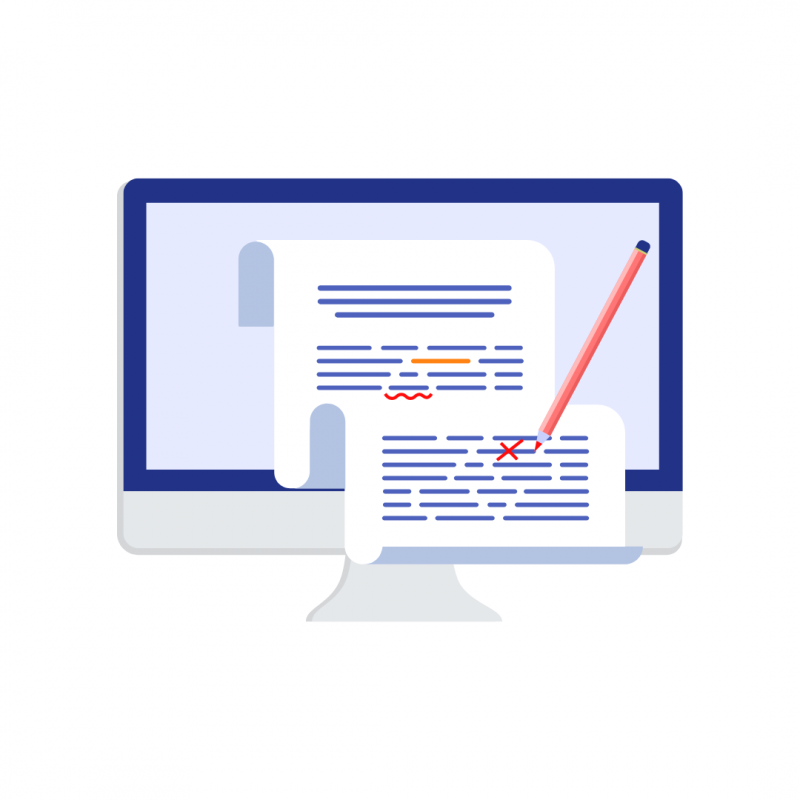2. READING
💡 In academic context, the purpose of reading is to grow your knowledge to be able to complete your course work or assignments. On this page you will learn about reading techniques, source evaluation, note taking and the use of mind maps to support your academic writing process.
a) Skimming and scanning
Step 1:
Skimming
Since you won’t have time to read every source you come across in-depth, using a variety of study techniques will make your study sessions go more easily. The process of determining if a source is suitable and relevant for your project is known as skimming. The first question you should ask yourself is if it satisfies the specifications listed in your assignment brief.
When Skimming a text, it is all about taking a quick glance at the text to understand the main message.
Pay special attention to:
- The abstract or summary
- The introduction
- Any headings or subheadings
- Any lists or words in bold.
Step 2:
Scanning
After you’re certain that the source satisfies the prerequisites for your assignment, you can scan the article to learn more. Scanning means that you want to look for a specific piece of information. Using this method, you look for the most important phrases or ideas from your assignment topic, focusing exclusively on the details that are most important to you.
Look for the following aspects:
- Thesis statement – found in the last sentences of the introduction
- Introduction
- Conclusion
- Summary (if it has one)
- Sub-heading and first sentence of every paragraph
Use CTRL + F (or Command + F on a Mac) to find specific words in a text.
b) Intensive reading
Intense reading involves thorough reading in order to fully understand the author’s thesis along with relevant details. When reading thoroughly, as opposed to skimming and scanning, you should carefully read the source word for word to make sure you understand everything. Now that you’ve confirmed the text’s relevancy and appropriateness through your skimming and scanning, you should start taking notes from it. See the instructions for different methods of taking notes on this page.
You should actively consider what you are reading while you read, making sure to keep your thesis statement and assignment question on your mind.
c) Critical reading
One part of intensive reading is critical reading where the reader should evaluate, analyse and question the authors arguments.
This Checklist might help you:
✅Checklist: Critical Reading
- Authorship and Expertise: Who wrote it, and are they an expert?
- Clarity and Effectiveness: Is the topic presented clearly and effectively?
- Research Support: Are views backed up by valid and thorough research?
- Author’s Intent: What is the author trying to do? Persuade, inform, or share research findings?
- Language Analysis: Examining language for persuasion or manipulation.
- Intended Audience: Identifying the target audience.
- Publication Context: Where was it published, indicating the focus area?
- Point of View: Does it consider multiple perspectives or have a bias?
- Original Context: Understanding the original context compared to the current one.
- Time Period: When was the research done or published
d) Evaluating sources and lateral reading
The author’s and the information’s credibility should be taken into account when choosing whether or not to include a source in your argument. When analyzing a text, consider the following questions for yourself:
- Who
Evaluate the author or the organisation responsible for the content. Are they qualified enough to write about the subject? Do they provide proof of a conflict of interest or prejudices?
- Why
Why was the content created? Is it meant to entertain, educate, convince, or promote a product? Giving just one side of the narrative or using strong, dramatic language could imply that the author is trying to influence or manipulate the reader.
- When?
In certain study fields, the information’s timing will be essential, and many assignment specifications will specify an acceptable publishing timeframe. You must be aware of the publication or update date of the information.
When assessing a source, you might need to use the lateral reading technique to verify the author’s claims and conclusions by searching the Internet for additional evidence or support.
Contact for Reading skill support
Email to LCFY (Language Center and Foundation Year): fy@vgu.edu.vn
Bibliography
Curtin University. (n.d.). Library | Curtin University, Perth, Australia. Retrieved April 15, 2024, from https://www.curtin.edu.au/library/
Copyright
Unless stated otherwise, all VGU Library content in any shape or form is covered by a Creative Commons Attribution ShareAlike 4.0 International License. Kindly give credit to VGU Library for any use of the content and include a link back to our library homepage.




